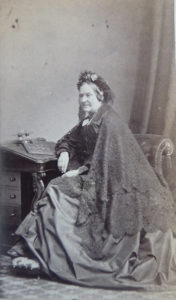Visitors to Devon in the 17th century marvelled at local lace-making. One remarked there was hardly a cottage in the county where white lace was not in production. The origin of the Devon bobbin lace industry is unclear. Was it introduced by Flemish refugees or inspired by Venetian pattern books? Was it a home-grown craft influenced by Continental fashions? Maybe all three. However it came about, lace-making thrived. The finished products were collected at Honiton for transport ‘up country’. Hence, it became known as Honiton lace.
In a major boost to the industry in 1840, the young Queen Victoria married Prince Albert in Honiton lace. The exuberant press coverage claimed the lace cost £1,000. This exaggeration underlined the quality and luxury associated with east Devon lace. In an era of mass production, its appeal came from the whimsical, handmade motifs.
This East Devon bobbin lace sprig is said to have been made as part of a commission for Queen Victoria in 1861. A collection of British and Continental lace was put together by Charlotte Treadwin (née Dobbs). Treadwin was an important lace dealer and manufacturer. She ran a successful business near Exeter Cathedral, where a team of skilled workers produced fine bobbin and needle laces.

Her great skill as a lace maker earned her a Royal warrant in 1848. Many royal commissions and prize medals followed. She exhibited at the Great Exhibition of 1851 and the International Exhibition of 1862.
Examples of Treadwin’s own work and collections were organised into an album by Ellen Herbert, her successor in the business. The collection was donated to the museum in the late 1860s for lace-makers and designers to study.
Treadwin was concerned that lace-makers were not trained to draw or design. She once stated that there was not a single lace-designer in the whole of Devon. Treadwin wanted to change this and employed an artist to draw out her designs. She would also improve her own practice by studying samples and experimenting with different patterns and techniques.
This content is viewable by members only. Login or sign up to get access.

